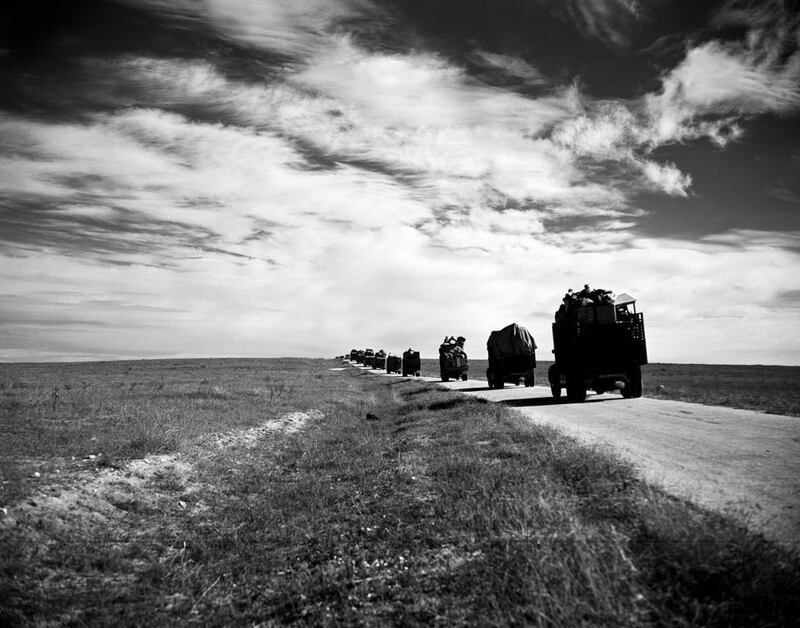Bir Zeit, West Bank // At a hilltop construction site in Bir Zeit, near Ramallah, a worker pushes a wheelbarrow through a terraced garden of olive saplings into a vast, partially completed one-storey structure. Men in hard hats and fluorescent vests rush about while others perch on ladders, hammering near a wall of grey concrete.
Eight months before its scheduled opening, what will soon be the first national museum for the geographically dispersed Palestinian people is not only taking shape physically but conceptually.
“This will be the exhibit area,” said Rana Anani, spokeswoman for the Palestinian Museum.
“There will be an elevator here to move artwork from the storage area,” she added, pointing to a shaft.
The museum’s director Jack Persekian, is finalising the opening exhibits and hoping that with participation of Palestinians from around the world, it will become a unifying force that transcends borders.
“The goal is to connect the Palestinians and present different narratives to the world of who we are, where we come from and what we aspire to,” said Mr Persekian, a Palestinian from East Jerusalem, who was the director of the Sharjah Biennial from 2005 to 2011.
The idea behind the museum was first conceived by the Welfare Association – an organisation established by Palestinian philanthropists – in 1997. It was initially meant to commemorate the 50th anniversary of the nakba, or catastrophe in 1948, when Palestinians were displaced during the war which led to Israel’s birth.
The project was put on hold when the second intifada erupted in 2000, and revived again beginning in 2005, with a decision taken to broaden it beyond the nakba.
“People questioned the need to pitch the story of Palestine against the Israeli story and asked why do we need to talk about our history, people and culture always within the context of the creation of Israel and its aftermath,” Mr Persekian said.
But unlike most national museums, the Palestinian Museum’s primary target audience is fragmented and dispersed. Many Palestinians – such as Gazans who cannot journey to the West Bank due to Israeli travel strictures – cannot reach it at all, while more than half of the world’s Palestinians are scattered far outside of Palestine in a diaspora spanning six continents.
In view of this, the Palestinian Museum seeks to become the hub connecting a network of institutions in Jordan, Beirut, Gaza, Haifa and elsewhere.
The museum plans to support institutions as they develop their collections and make them more accessible to visitors, hoping that these institutions will one day become “satellites” that bridge the Palestinian Museum and local Palestinian populations, said Mr Persekian.
“The satellites will provide physical connection with centres of where Palestinians live. People talk about having online connections, that people anywhere can access your website. But we wanted to take it a step further and actually make the effort of reaching out and forging connections with existing institutions and make partnerships.’’
The first exhibit of the museum, which Mr Persekian hopes will open simultaneously in May next year in Bir Zeit, London and Santiago, Chile, is “Never Part”, which seeks to tell the stories of Palestinians through cherished objects they carried with them over the years.
“Through the objects, we reflect on the personal identity of people and their history collectively. It’s the story of Palestinians told in many, many voices.”
Among the 280 objects are keys, a comb, a bed and even a cactus plant carried by a refugee from Jaffa in 1948 who gave offshoots to his sons and daughters.
Soliciting the objects from the public through social media reflects the museum’s efforts to emanate from, and involve, ordinary Palestinians, Mr Persekian said.
“We wanted to demystify the whole concept of the museum, so rather than telling people what they need to know about Palestinians, we wanted the people themselves to bring in the objects so there is a connection with ordinary people. ... We wanted to completely open up the museum through the objects.’’
The museum’s Family Album project is also under way. It is an ambitious attempt to build a visual archive for Palestinians by gathering and scanning collections of photographs, recording oral histories from their owners and writing captions.
Wijdan Obeid, an elderly woman from East Jerusalem, submitted 343 pictures that belonged to her father, Ali, who was part of the construction workers’ union there. The black and white pictures, some of them torn, show building sites on which Ali worked in Amman, Kuwait and Baghdad during the 1950s and 1960s, casting light on how Palestinians often migrated across the Arab world for work.
“It takes a lot of time but I really enjoy doing this,” said Natalie Masri, 23, a museum employee who was scanning the collection.
“It is very important for the next generations to have our history and our grandfather’s history.”
Nazmi Jubeh, a historian at Bir Zeit University, believes a national museum is long overdue.
“There is a crucial need for an educational museum to educate people, foremost Palestinians, about their history.”
“There is no one single museum that presents the Palestinian narrative. It is time to open such a museum,” he said.
foreign.desk@thenational.ae
* An earlier version of this article called the Welfare Association the Welfare Society. The organisation has offices in Ramallah, Lebanon and London.





